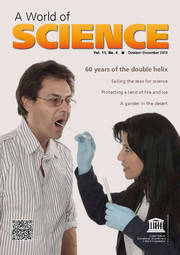Vol 3 N° 2 [April–June 2005]
CONTENTS
IN FOCUS
p 2 - Killer wave
NEWS
p 9 - Island agenda
p 9 - UNESCO and NASA strengthen ties
p 10 - Five nano-giants celebrated
p 11 - Scientific advisory body for CBD mooted
p 12 - Shipment for Iraqi universities
INTERVIEW
p 13 - Four young scientists on why their opinions should be canvassed
HORIZONS
p 16 - Controlling malaria, the vampire of the technological age
p 20 - The knowledge that saved the sea gypsies
IN BRIEF
p 24 - Diary
p 24 - New releases
p 24 - Governing bodies
Quick link to Vol. 3 n° 2 (PDF document);
See also ARCHIVES for A World of Science
EDITORIAL
The cost of playing the waiting game
Until 26 December, the World Conference on Disaster Reduction was just another rendez-vous on the United Nations calendar. On the first anniversary of the Bam tragedy, memories were fading of the 6.5 magnitude earthquake which had destroyed 80% of the ancient city in 12 seconds.
Then, 23 days before the Kobe conference got under way on 18 January, an underwater earthquake in the Indian Ocean generated the most destructive tsunami in living memory. Instantly, languishing plans for a tsunami early warning sys-tem for the Indian Ocean shot up the conference agenda. Within days, UNESCO could count on the support of numerous organizations and countries for the new warning system, the same one UNESCO had first proposed several years earlier. Given that the last ocean-wide tsunami in the Indian Ocean went back to 1883, the system had not been considered a priority; not, that is, until last December’s earthquake and tsunami killed quarter of a million people in a single day.
The tsunami early warning system for the Indian Ocean should be in place by 2007. In this issue, we look at what the new system will entail and at progress thus far. Meanwhile, in Bam, reconstruction is progressing slowly. The Iranian authori-ties have reiterated their intention to ensure that seismic building codes are observed. This should make the new structures as resilient to earthquakes as those of Fukuoka on the island of Kyushu (Japan), which suffered an earthquake of mag-nitude 7 as recently as 19 March. More than 26,000 people were killed in Bam; one person in Fukuoka. As Charles Richter, inventor of the scale of earthquake magnitude measurement, puts it, ‘Earthquakes don’t kill people, buildings do’.
We may not be able to predict natural hazards but we do know how to minimize loss of life and property, through building codes, zoning, early warning systems and other forms of disaster preparedness and prevention. Yet, so often, the tempta-tion is to wait until disaster strikes to act. We are like the man with a hole in his roof who, when asked why he doesn’t have it repaired, answers, ‘when it’s rain-ing, the roof cannot be fixed; when it is not raining, there is no need to’.
Some may argue that prevention has a cost. They would be right. It does. The cost of instigating the Indian Ocean tsunami early warning system has been esti-mated at $30–50 million. But that is a drop in the ocean compared to the bill for recovery from last December’s megatsunami. And no amount of reconstruction will bring back the dead.
W. Erdelen
Assistant Director-General for Natural Sciences

